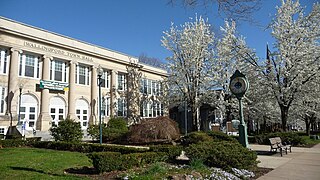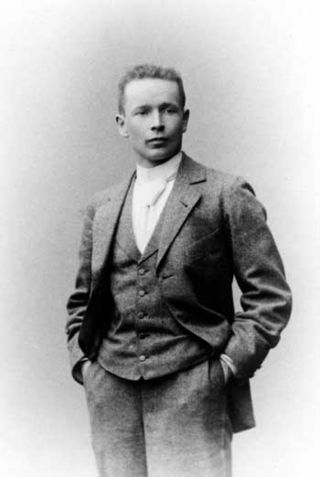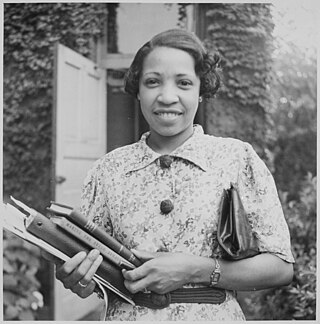
Louis Comfort Tiffany was an American artist and designer who worked in the decorative arts and is best known for his work in stained glass. He is associated with the art nouveau and aesthetic art movements.

Wallingford is a town in New Haven County, Connecticut, United States, centrally located between New Haven and Hartford, and Boston and New York City. The town is part of the South Central Connecticut Planning Region. The population was 44,396 at the 2020 census. The community was named after Wallingford, in England.

Meriden is a city in New Haven County, Connecticut, United States, located halfway between the regional cities of New Haven and Hartford. The city is part of the South Central Connecticut Planning Region. In 2020, the population of the city was 60,850.

Gottlieb Eliel Saarinen was a Finnish-American architect known for his work with art nouveau buildings in the early years of the 20th century. He was also the father of famed architect Eero Saarinen.

The Museum of Fine Arts is an art museum in Boston, Massachusetts, United States. It is the 20th-largest art museum in the world, measured by public gallery area. It contains 8,161 paintings and more than 450,000 works of art, making it one of the most comprehensive collections in the Americas. With more than 1.2 million visitors a year, it is the 79th–most visited art museum in the world as of 2022.

The Boston Athenaeum is one of the oldest independent libraries in the United States. It is also one of a number of membership libraries, for which patrons pay a yearly subscription fee to use Athenaeum services. The institution was founded in 1807 by the Anthology Club of Boston, Massachusetts. It is located at 10½ Beacon Street on Beacon Hill.

Lois Mailou Jones (1905–1998) was an artist and educator. Her work can be found in the collections of the Smithsonian American Art Museum, The Metropolitan Museum of Art, the National Museum of Women in the Arts, the Brooklyn Museum, the Museum of Fine Arts, Boston, Muscarelle Museum of Art, and The Phillips Collection. She is often associated with the Harlem Renaissance.

Charles Sheeler was an American artist known for his Precisionist paintings, commercial photography, and the avant-garde film, Manhatta, which he made in collaboration with Paul Strand. Sheeler is recognized as one of the early adopters of modernism in American art.

David Vincent Hayes was an American sculptor.

The Napier Company is an American jewelry manufacturing company, and was one of the first modern corporations in the United States. The company is also known historically as a cutting-edge silver object manufacturer.

The Bradley & Hubbard Manufacturing Company (1852–1940) was formed in Meriden, Connecticut, and over the years produced Art Brass tables, call bells, candlestick holders, clocks, match safes, lamps, architectural grilles, railings, etc. Overall the company patented 238 designs and mechanical devices. "By the 1890s, the Bradley and Hubbard name was synonymous with high quality and artistic merit," said Richard E. Stamm for the Smithsonian Institution, which has an extensive collection of Bradley and Hubbard manufactured design objects in its collection.

The International Silver Company , later known as Insilco Corporation and also known as the ISC, was formed in Meriden, Connecticut as a corporation banding together many existing silver companies in the immediate area and beyond.
The Miller Company Collection of Abstract Art was formed in Meriden, Connecticut, as part of the Miller Company. The collection was formed by then CEO Burton Tremaine Sr. and his wife, Miller Co. art director Emily Hall Tremaine in 1945. Works from the collection were featured in the Painting Toward Architecture exhibition, putting forth post-WWII art, design and architecture crossovers, originating at the Wadsworth Atheneum in Hartford, CT, and traveling to 28 additional venues in 1947–1952 across the United States.

The Meriden Britannia Company was formed in 1852 in Meriden, Connecticut, as a manufacturing company focused on producing wares in britannia metal. It became, for a time, the largest silverware company in the world.
The Charles Parker Company was formed in Meriden, Connecticut by Charles Parker, and over the years manufactured products including metalware, Art Brass, hardware, lamps, spectacles, and piano stools. Also related to the company were others founded by Charles Parker: including Parker Brothers, Meriden Curtain Fixture Co., and Parker & Whipple Co. clock manufacturers.
R. Wallace & Sons was formed in Wallingford, Connecticut, and incorporated in 1879. As of 1893, this company manufactured silver and plated ware and cutlery and had about 600 employees.

The Eydam and Handel Company, or Adolph Eydam and Philip Handel Company, was formed in 1885, until partnership broke up in 1892 when Eydam moved to rival company of C. F. Monroe. It was formed in Meriden, Connecticut, and over the years produced lamps and glass designs. The company was incorporated in 1903. As of c. 1911, P. J. Handel was president and treasurer of the business. In Meriden Illustrated, "[The company has] obtained [a] national reputation for the artistic and the high quality of their product. A number of patents are controlled which makes their business a very successful one. There is a force of 125 people skilled in the various branches and steadily engaged." Also at this time, the Handel Company maintained a showroom in New York City at the corner of West Broadway and Murray St. with dedicated sales agents for the entire United States. The production location was in Meriden on East Main Street, just east of Broad Street.
In 1872, the Derby Silver Company began production in Derby, CT. Over the years, the company made bathroom-related items, clocks, tableware and flatware, tea sets, candlesticks, fruit baskets, dishes, and more object types made of silver and silver plate. The Derby Silver Company operated showrooms in New York, Chicago, and San Francisco. As of 1893, the President and Manager of the company was Watson J. Miller. Wesley L. Clark was the Secretary and Treasurer.

The Wilcox Silver Plate Co. was formed in Meriden, Connecticut. From 1865 to 1867, it was known as the Wilcox Brittania Co. In 1898, the company was acquired by the International Silver Company, headquartered in Meriden. After the acquisition, the Wilcox Silver Plate Co. brand continued until at least c. 1980.
Edward Miller & Co. (1844-1924) was formed in Meriden, Connecticut, and is primarily known as a historical manufacturer of lamps. The company also made brass kettles and oil heaters. In 1866, the corporation was formed with capital of USD$200,000. Its earlier beginning included being started by Horatio Howard. The following year the business was sold to Edward Miller.















